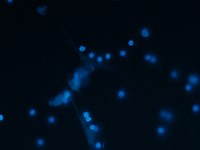
Photo from wikipedia
Neutrophil extracellular trap (NET) is one of the first-line defenses against microbes. Under certain circumstances, however, it also plays an aggravating factor in diverse inflammation-related diseases including cancers and vascular… Click to show full abstract
Neutrophil extracellular trap (NET) is one of the first-line defenses against microbes. Under certain circumstances, however, it also plays an aggravating factor in diverse inflammation-related diseases including cancers and vascular diseases. Our aim is to develop a new method to detect NET in cells and tissues using a DNA-specific fluorescence probe CDr15. CDr15 was characterized to be impermeable to the cell membranes and to emit a strong fluorescence in association with extracellular DNAs in NET. Due to these properties, CDr15 was successfully shown to quantify NETs in vitro and to be applicable for real-time monitoring NET formation in PMA-stimulated neutrophils. Even in formaldehyde-fixed tumor specimens, CDr15 could detect NETs spreading around cancer cells. Compared with DAPI and SYTOX DNA dyes, CDr15 showed a lower level of background fluorescence and a higher specificity in NET detection. Based on these results, we propose CDr15 as a novel marker of NET to be applicable in experimental and clinical studies.
Journal Title: Biochemical and biophysical research communications
Year Published: 2020
Link to full text (if available)
Share on Social Media: Sign Up to like & get
recommendations!